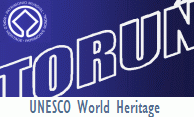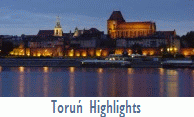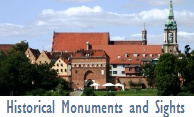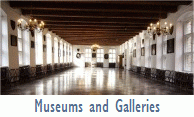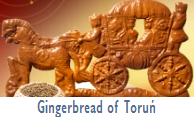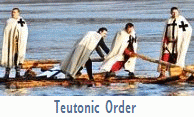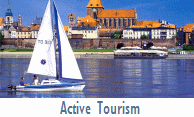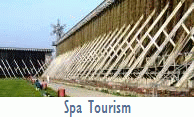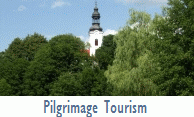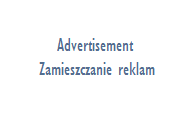|
Teutonic Castle Ruins
Ruiny zamku krzyżackiego
Address: Opening hours: High season (March - October): everyday: 10am - 6pm Low season (November-February): everyday: 10am - 4pm Admission fees (without reservation charge): 8 PLN, reduced: 5 PLN, family: 16 PLN Booking guides, entrance tickets, further details: Toruński Serwis Turystyczny, tel. (+48) 66 00 61 352, e-mail: muzeum@turystyka.torun.pl  • More about the castle here
• More about the Teutonic Order here
The area of the castle remnants comprises the main castle ruin with the cellars and Gdanisko Tower preserved.
It was the very first castle of the Teutonic Knights from which the colonization of pagan Prussians and creating Teutonic state started. The castle was a residence of Teutonic Commander. It was destroyed in 1454 during the Toruń's burgher uprising against the Teutonic Knights what in succession caused the 13-years Polish-Teutonic War ended by signing famous Second Toruń Treaty in 1466. It was only 1966 when the ruins was explored and prepared for tourists. Permanent exhibitions:
 Armoury ArmourySadly, locating the former armoury in Toruń castle is no longer possible due to the extensive damage the castle suffered as far back as the Middle Ages. Its existence, however, has already been acknowledged. Teutonic castles, which regularly served as centres of resistance, stored weaponry for defensive purposes. Continuous military operations led by the Teutonic knights created the need for incessant weapon replacement and maintenance. In the Middle Ages, the castle armoury included both protective gear (e.g. armours, helmets, shields) and arms (crossbows or axes), as well as rampart arms of heavy calibre and artillery. The armoury can be found in the vaults. i  The kitchen was located in the south-east part of the main castle building. In July 2008, the excavation works in the remains of the kitchen revealed, among other things, a bracteat, a Teutonic coin and a dice … The kitchen was located in the south-east part of the main castle building. In July 2008, the excavation works in the remains of the kitchen revealed, among other things, a bracteat, a Teutonic coin and a dice … The brothers ate two meals a day: a dinner and a supper. On fasting days, the dinner was served before noon, and for supper every two brothers received four quarts of beer or mead to share. Meat was served three times a week, and in the period between St. Martin’s Day and Christmas and between the Pentecoste and Easter, as well as the on the eves of seventeen holidays, strict fast was observed. An exemplary food stock list in Toruń Commander’s granary as of 24 August 1375 included 180 meat pieces, 25 barrels of lard, 60 stones (12,96 kg) of fat, 4 barrels of butter, 5000 pieces of cheese, around 9000 l of salt, 900000 l of grain (both in stock and on loan), 3000000 l of oat, 300 000 l of hops. The reconstructed kitchen can be found in the vaults. i  Dormitory DormitoryThe vaults additionally contain a reconstructed Teutonic bedroom – the dormitory, which was discovered during the excavation works in the southern wing of the castle, precisely in its western part. All brothers who enjoyed a good health went to bed simultaneously, except for those whose duties kept them busy in some other place. They slept half-dressed by the candle-light. Their bed and bedding consisted of a straw-filled mattress, a blanket, a sheet, a linen or goat-skin cover and a pillow. However, the final number of bedding elements they were allowed to have depended on their superior, who had the authority to give them as many of these as he wished. i  Scriptorium Scriptorium The exact location of this room remains unknown. Some of the brothers could read and write and thus they were set the task of producing a variety of documents or registers and recording all kinds of data and other information. They wrote on paper or parchment and their writing instruments included bird feathers, metal styles and reed. To keep the handwriting even they drew pencil lines to indicate the space on which to write. Letters were written in ink, while the initials and titles were made with minium or dyes. i  Gdanisko GdaniskoA sanitary and defence tower. Connected with the castle building by a gallery, the tower served two purposes: it defended the eastern part of the castle walls and was used as a lavatory. Erected on the marsh upon Struga Toruńska banks, Gdanisko survived the demolition of the castle by Toruń burghers in the 15th century. In 1600-1613, on the initiative of Toruń burgomaster Heinrich Stroband, the remains of the castle became a triangular rampart protecting the city from the south, and the tower was transformed into a powder magazine. Inside one can see immense joists which survived from the period. i  The vaults of the castle are the biggest tourist attraction, housing most of the permanent exhibition relating to the life of the Teutonic Knights in the Middle Ages. The vaults, revealed by the excavation works in 1958-1966, have survived only partially and have been reconstructed and lowered. The excavation works revealed also some architectural details such as column and portal fragments or floor elements from the castle chapel. These are currently stored in the vaults. The vaults of the castle are the biggest tourist attraction, housing most of the permanent exhibition relating to the life of the Teutonic Knights in the Middle Ages. The vaults, revealed by the excavation works in 1958-1966, have survived only partially and have been reconstructed and lowered. The excavation works revealed also some architectural details such as column and portal fragments or floor elements from the castle chapel. These are currently stored in the vaults. i The mint Located in the bailey, the mint is an attempt to reconstruct the technique of producing medieval Teutonic coins. A thirty-minute show presents a brief history of minting in the Teutonic State and the actual process of minting coins. The latter begins with heating up metal in a suitable kiln. The liquid metal is then poured into a wooden mold and cooled, and metal stripes, called ‘cans’, are formed. They are then repeatedly hammered until they acquire a silvery colour and, finally, impressed with a special seal bearing the pattern used in 1245. The show presents also the tools used to produce coins and the minter’s uniform. The minting process has been faithfully reconstructed on the basis of medieval prints and descriptions (the 13th-15th centuries) and follows Toruń tradition of minting. i
|
| All rights reserved Toruń 2005-2009 | About us | CenterMedia |



